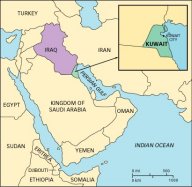


Page 4 of 4
In the middle of January 1991, after President Bush had gone the “extra mile for peace” to no avail, Operation Desert Storm began. Saddam Hussein had promised “the mother of all battles” but, as it turned out, the contest was entirely one-sided. Desert Storm began with a massive aerial assault which effectively neutralized the Iraqi air force. In the following weeks, alliance forces systematically degraded Iraq’s military command and control system and a considerable proportion of Iraq’s infrastructure. In response, at the end of January, Iraq emptied oil from some Kuwaiti storage tanks (the equivalent of some four million barrels) into the Gulf in an act of mindless ecological irresponsibility. The oil spill, probably the worst ever, caused considerable environmental damage but clearly had no military purpose or effect.
Also in late January, Iraqi forces crossed into Saudi Arabia, briefly occupying the deserted northern town of al-Khafji. The Iraqi invaders were speedily repelled by alliance forces with Saudi units in the van.
While the alliance was deconstructing Iraq, Saddam Hussein retaliated with Scud missiles (armed with conventional explosive warheads) launched against Riyadh and other targets in the Kingdom. Most of the missiles were inaccurate.
When the land war to liberate Kuwait was launched, it was over almost before it began. What was left of Iraq’s occupying forces was incapable of serious resistance.
Saudi Arabia had committed its entire armed forces to the operation of liberating Kuwait.

